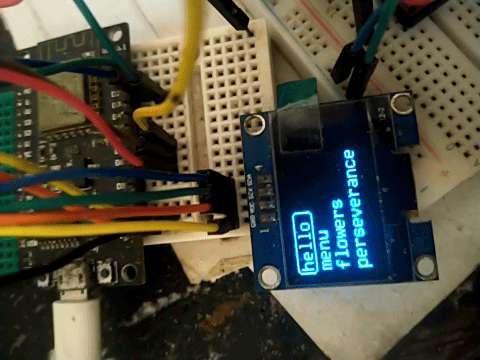U8g2菜单界面+按键操作在线模拟控制

✨利用U8g2库在线模拟菜单功能,可以很方便的快速调试效果。
🌼Demo1代码
- 📌仿真地址:
https://wokwi.com/projects/291572875238834696
/*
* Very simple menu on an OLED display (with 8 lines of text).
* Displays menu items from the array menu. Max. number of items is 7.
*
* This sketch uses the library "U8g2", "Bounce2" and uses 3 buttons (up/down/select).
*
*/
#include <U8g2lib.h>
#include <Bounce2.h>
byte button_pins[] = {9, 5, 6}; // button pins, 4,5 = up/down, 6 = select
#define NUMBUTTONS sizeof(button_pins)
Bounce * buttons = new Bounce[NUMBUTTONS];
U8X8_SSD1306_128X64_NONAME_HW_I2C display(U8X8_PIN_NONE);
#define MENU_SIZE 5
char *menu[MENU_SIZE] = { "Option 1", "Option 2", "Option 3", "Option 4", "Option 5" };
int cursor=0;
void setup() {
Serial.begin(9600);
// Make input & enable pull-up resistors on switch pins
for (int i=0; i<NUMBUTTONS; i++) {
buttons[i].attach( button_pins[i], INPUT_PULLUP); // setup the bounce instance for the current button
buttons[i].interval(25); // interval in ms
}
display.begin();
display.setPowerSave(0);
display.setFont(u8x8_font_pxplusibmcgathin_f);
showMenu();
}
void loop() {
// process button press:
for (int i = 0; i<NUMBUTTONS; i++) {
buttons[i].update(); // Update the Bounce instance
if ( buttons[i].fell() ) { // If it fell
if (i==2) { // select
display.clearLine(7);
display.setCursor(0,7);
display.print(">>");
display.print(menu[cursor]);
executeChoice(cursor);
}
else {
// erase previous cursor:
display.setCursor(0,cursor);
display.print(' ');
if (i==0) { // up
cursor++;
if (cursor>(MENU_SIZE-1)) cursor=0;
}
else { // down
cursor--;
if (cursor<0) cursor=(MENU_SIZE-1);
}
// show cursor at new line:
display.setCursor(0,cursor);
display.print('>');
}
} // end if button fell...
} // end for-loop of button check
}
/**
* Clear display and show the menu.
*/
void showMenu() {
cursor=0;
display.clearDisplay();
// show menu items:
for (int i = 0; i<MENU_SIZE; i++) {
display.drawString(2,i,menu[i]);
}
display.setCursor(0,0);
display.print('>');
}
/**
* Execute the task which matches the chosen menu item.
*/
void executeChoice(int choice) {
switch(choice) {
case 0 :
Serial.print("Execute choice "); Serial.print(choice); Serial.print(" - "); Serial.println(menu[choice]);
break;
case 1 :
Serial.print("Execute choice "); Serial.print(choice); Serial.print(" - "); Serial.println(menu[choice]);
break;
case 2 :
Serial.print("Execute choice "); Serial.print(choice); Serial.print(" - "); Serial.println(menu[choice]);
break;
case 3 :
Serial.print("Execute choice "); Serial.print(choice); Serial.print(" - "); Serial.println(menu[choice]);
break;
case 4 :
Serial.print("Execute choice "); Serial.print(choice); Serial.print(" - "); Serial.println(menu[choice]);
break;
default :
Serial.print("Execute choice "); Serial.print(choice); Serial.print(" - "); Serial.println(menu[choice]);
break;
}
}
🌻Demo2代码
-
📍滚动菜单


-
📌
https://wokwi.com/projects/353353893815793665
#include <U8g2lib.h>
#include <Wire.h>
#include <math.h>
typedef struct
{
byte val;
byte last_val;
}KEY_T;
typedef struct
{
byte id;
byte press;
byte update_flag;
byte res;
}KEY_MSG;
typedef struct
{
char* str;
byte len;
}SETTING_LIST;
SETTING_LIST list[] =
{
{"hello",5},
{"menu",4},
{"flowers",7},
{"perseverance",12},
};
U8G2_SH1106_128X64_NONAME_F_HW_I2C u8g2(U8G2_R0, /* reset=*/ U8X8_PIN_NONE);//该驱动是1.3寸的OLED屏幕。---------U8G2_SSD1306_128X64_NONAME_F_HW_I2C u8g2(U8G2_R0, /* reset=*/ U8X8_PIN_NONE);这是比较常用的0.9寸的OLED显示器的驱动
short x,x_trg; //x当前位置数值,x_trg 目标坐标值
short y = 15,y_trg = 15;
short frame_len,frame_len_trg;//框框的宽度
short frame_y,frame_y_trg;//框框的y
char ui_select = 0;
int state;
KEY_T key[2] = {0};
KEY_MSG key_msg = {0};
byte get_io_val(byte ch)
{
if(ch == 0)
{
return digitalRead(2);
}
else
{
return digitalRead(3);
}
}
void key_init(void)
{
for(int i = 0;i<2;i++)
{
key[i].val = key[i].last_val = get_io_val(i);
}
}
void key_scan(void)
{
for(int i = 0;i<2;i++)
{
key[i].val = get_io_val(i);
if(key[i].val != key[i].last_val)
{
key[i].last_val = key[i].val;
if(key[i].val == 0)
{
key_msg.id = i;
key_msg.press = 1;
key_msg.update_flag = 1;
}
}
}
}
int ui_run(short *a,short *a_trg,u8 step,u8 slow_cnt)
{
u8 temp;
temp = abs(*a_trg-*a) > slow_cnt ? step : 1;
if(*a < *a_trg)
{
*a += temp;
}
else if( *a > *a_trg)
{
*a -= temp;
}
else
{
return 0;
}
return 1;
}
void setup(void)
{
pinMode(2, INPUT_PULLUP);
pinMode(3, INPUT_PULLUP);
key_init();
u8g2.begin();
u8g2.setFont(u8g2_font_t0_16_tf ); //设置字体
frame_len = frame_len_trg = list[ui_select].len*10;
}
void ui_show(void)
{
int list_len = sizeof(list) / sizeof(SETTING_LIST);
u8g2.clearBuffer(); // 清除内部缓冲区
for(int i = 0 ;i < list_len;i++)
{
u8g2.drawStr(x+2,y+i*14,list[i].str); // 第一段输出位置
}
u8g2.drawRFrame(x,frame_y+2,frame_len,16,3);
ui_run(&frame_y,&frame_y_trg,5,4);
ui_run(&frame_len,&frame_len_trg,10,5);
u8g2.sendBuffer(); // transfer internal memory to the displa
}
void ui_proc(void)
{
int list_len = sizeof(list) / sizeof(SETTING_LIST);
if(key_msg.update_flag && key_msg.press)
{
key_msg.update_flag = 0;
if(key_msg.id)
{
ui_select++;
if(ui_select >= list_len)
{
ui_select = list_len - 1;
}
}
else
{
ui_select--;
if(ui_select < 0)
{
ui_select = 0;
}
}
frame_y_trg = ui_select*14;
frame_len_trg = list[ui_select].len*10;
}
ui_show();
}
void loop(void)
{
key_scan();
ui_proc();
}
























 1115
1115











 被折叠的 条评论
为什么被折叠?
被折叠的 条评论
为什么被折叠?








